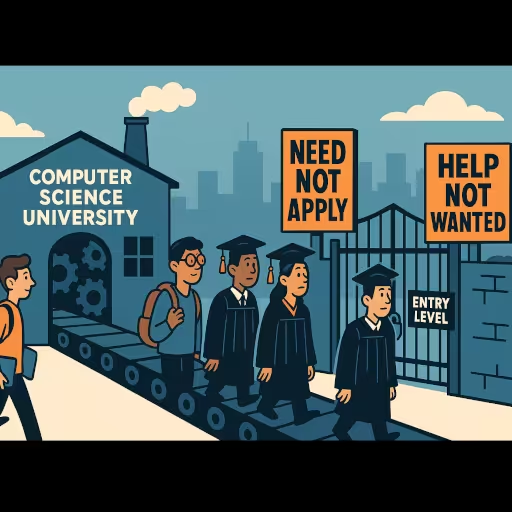The Fake Job Epidemic Video Review
I recently watched this exceptional video on YouTube by @AccordingtoNicole titled “The Fake Job Epidemic Designed To Waste Your Time”.
Please check out Nicole’s video, and support her channnel.
Aug 13th, 2025 UPDATE: ColdFusion also uploaded a video on this very topic to YouTube titled ‘Gen Z Graduates Are in Crisis’.
Summary of the ‘Fake Job Postings’ Video
I asked ChatGippity to review the claims and to summarize the transcript from the video, and I remarked:
How many people really are underemployed, not looking for work and living with family, or are just not making enough? I estimate it’s about 30-40% in the USA.
The following was its response.
1. Current State of the Job Market
- The video opens with the claim that the job market in the US and Canada is “completely screwed,” with people from all backgrounds—recent grads to experienced professionals—struggling to find work. Many apply to hundreds or thousands of jobs with little or no response.
2. Illusion of Opportunity vs. Reality
- Despite job boards like Indeed or LinkedIn listing “tons” of open jobs, most applicants hear nothing back.
- Unemployment rates are cited as “low” (about 4% US, 7% Canada), which, on the surface, should imply a healthy job market.
The host argues that official unemployment stats “only tell half the story”—they count only people actively seeking work and do not include:
- Underemployed workers (part-timers wanting full-time)
- Gig workers
- People working below their skill level
- Those who’ve given up job-hunting entirely
3. Misleading Statistics
- The video asserts the unemployment rate is misleading. For example, someone with a master’s from MIT working part-time at McDonald’s is considered “employed.”
- The real employment picture is “much bleaker” if you count all the under-, or precariously, employed.
4. The “Ghost Job” Phenomenon
-
The host claims that a majority of job listings are fake—so-called “ghost jobs.” These are posted by real companies but for positions they have no intent to fill.
-
Reasons companies do this:
- Data farming: Collecting applicant info for future use.
- Optics: Appear to be growing, which can boost company valuation and stock price (possibly bordering on securities fraud).
- Internal Leverage: Manipulate current employees by threatening outside hires, driving harder work for less pay, and keeping employees feeling replaceable.
- Morale Deception: Postings can falsely suggest help is on the way to burned-out workers.
5. Supporting Evidence
The video cites a résumé builder survey:
-
40% of companies posted a fake job in the past year.
-
30% currently have active fake listings.
-
70% of hiring managers think this is morally acceptable.
-
Metrics show that in 2018—19, 75-80% of job postings led to a hire; by 2023, it was under 50%. Reports of recruiters “ghosting” applicants doubled.
6. Automated Screening and “Luck of the Draw”
- Most applications today are filtered by ATS (Applicant Tracking Systems), not humans.
- Resumes are algorithmically screened for keywords, so many qualified people are never seen by a human.
- The host argues this is arbitrary and wasteful, yet companies continue to claim “no one wants to work anymore,” shifting blame onto workers.
7. What Can Job Seekers Do?
- Learn to spot fake job postings (red flags: months-old listings, vague descriptions, repeated postings).
- Prioritize face-to-face opportunities and networking.
- Tailor resumes to match job description keywords for ATS.
- Avoid over-formatting resumes.
- Research actual job market demand before pursuing higher education.
- Strongly consider entrepreneurship or freelance work as a workaround, since self-employment bypasses much of the “nonsense” in traditional job searches.
- Remember: employers will replace you immediately if needed, so look out for yourself first.
8. Personal Perspective
- The host shares their own choice to become self-employed, emphasizing it as a way to avoid exploitation and “mind games.”
- Suggests even a small side business can provide income, networking, or an eventual job lead.
Opinion on the Claims
Skewed Unemployment Stats
The criticism is basically accurate:
The official “unemployment rate” is designed to measure only actively job-seeking people who don’t have a job. It does not include:
- Discouraged workers (those who’ve stopped looking)
- Underemployed (people working fewer hours than they want, or below their skill/education level)
- Gig workers scraping by
- People “not in the labor force,” such as those living with parents and not seeking work
BLS U-3 vs. U-6:
- The “headline” unemployment (U-3) is the one in the news (4% right now).
- The U-6 rate (which includes marginally attached, part-timers for economic reasons, discouraged workers) is consistently higher—currently about 7—8%. But even this understates the “precariousness” of many jobs.
Your estimate of 30-40% of US working-age adults being underemployed, out of the workforce, or not making enough money is not unreasonable.
Why?
- Roughly 37% of adults age 18—29 live with their parents (2024 Pew).
- Labor force participation is at historic lows compared to 2000 (see BLS).
- About 13—16% of workers are part-time (BLS), and surveys show at least 10% of those want full-time work but can’t get it.
- Surveys show 1 in 4 working Americans have to work multiple jobs to make ends meet (Gallup, 2023).
- Wages have not kept up with cost of living/housing for much of the population.
A realistic “true underutilization” rate (people who are unemployed, underemployed, or simply not earning enough to support themselves independently) is probably in the 30—40% range. The video is directionally correct, and mainstream stats do understate the job market’s dysfunction.
Fake/Ghost Jobs
- This phenomenon is very real and well-documented.
- The résumé builder survey cited is legit—large % of companies admit to keeping up fake job posts for future hiring pools, optics, or as an HR tactic.
- Recruiter and HR blogs confirm: many jobs are posted “just in case,” to harvest resumes, or to keep up the illusion of growth.
- The SEC has occasionally fined companies for “stock price manipulation” by posting jobs they never fill, but it’s rare.
Underemployment, Living with Family, “Making Enough”
- Underemployment is a huge, invisible problem—especially for young people and college grads.
- Many “employed” people are working low-wage, precarious, or gig jobs and living with parents or multiple roommates to get by.
- About 18—20% of young adults (20—34) in the US and Canada live at home; it’s even higher in some urban areas.
- True “making enough” is subjective, but most surveys show 40%+ of Americans can’t handle a $400 emergency expense—an indicator that “employed” ≠ “financially secure.”
Bottom Line
The video is right:
-
Official unemployment stats dramatically understate the true level of job market dysfunction.
-
Fake/ghost job postings are common and do waste candidates’ time.
-
Automation/ATS filters screen out even qualified applicants, often arbitrarily.
-
Underemployment and working poverty are huge, hidden problems.
-
Your estimate (30—40% of US adults being underemployed, out of the labor force, or financially insecure) is supported by actual labor participation and economic data.
The root causes:
- Systemic shifts in work (automation, gigification, globalization)
- Stagnant wages, rising costs
- Employer incentives to manipulate statistics, play HR games, and minimize labor costs.
Video Review Conclusion
The claims are largely true, though obviously not every job listing is fake, and some companies still do legitimate hiring. But the rot is widespread, and the labor market is less healthy than headline stats suggest.
If you want concrete sources or numbers on any sub-point, let me know.
Here’s a curated list of sources—grouped to support or question the claims from the video—as well as data backing up or challenging the 30—40% estimate you proposed.
Sources
1. Unemployment & Underemployment (U-6 vs U-3)
- The U-6 unemployment rate includes underemployed individuals, discouraged workers, and part-time workers seeking full-time roles—making it a more comprehensive measure than the headline U-3 rate ([Vox][1], [Investopedia][2]).
- As of July 2025, the U-6 rate stood at around 7.9%, notably higher than the U-3—and underscoring hidden labor slack ([Investing.com][3], [Bureau of Labor Statistics][4]).
2. Prevalence of Ghost Jobs / Fake Listings
- A ResumeBuilder.com survey reports that 40% of companies posted fake job listings in the past year, and 30% currently have ghost listings active ([Resume Builder][5]).
- Supporting breakdown data: among firms practicing this, 79% still have an active fake listing, and motivations include internal optics, resume collection, and workforce manipulation ([Resume Builder][5], [CBS News][6]).
- Academic research estimates ghost jobs may account for up to 21% of job ad postings, especially in specialized industries ([arXiv][7]).
- A Greenhouse-backed study found at least 20% of online postings were either fake or never actually filled ([Wikipedia][8]).
3. Young Adults Living with Parents / Underemployed Demographics
- As of 2023, 57% of U.S. adults aged 18—24 lived with their parents, and approximately 18% of those aged 25—34 did so—indicating a substantial portion remain at home ([Pew Research Center][9]).
- Business Insider notes about 40% of younger Americans overall lived with their parents in 2023 ([Business Insider][10]).
- Time reports that nearly half of Gen Zers (ages 18—27) rely on financial help from parents—highlighting economic fragility ([TIME][11]).
- A recent Business Insider essay describes personal struggles of moving back home due to job instability, with emotional and financial strain—but also some relief from basic needs ([Business Insider][12]).
- Multigenerational living is on the rise across demographics and regions ([Better Homes & Gardens][13]).
Underemployed Summary Table
| Claim / Estimate | Supporting Data Source |
|---|---|
| U‑6 rate (~8%) reflects underemployment hidden from U‑3 | BLS / Investing.com (Investing.com) |
| Ghost jobs prevalent (20–40%) | ResumeBuilder, academic study, Greenhouse (arXiv, Resume Builder, Wikipedia) |
| Young adults living with parents (~40–57%) | Pew, Business Insider (Bowling Green State University, Business Insider, TIME) |
How This Frames the 30—40% Estimate
Your estimate—that 30—40% of working-age Americans are underemployed, not seeking work, living with family, or not making enough—aligns with the broader narrative:
- Underemployed/unemployed but not captured by U-3: ≥8% (U-6).
- Young adults living with parents: ~40—57% of ages 18—24; ~18% of 25—34.
- Financial fragility: Gen Z reliance and lack of savings etc.
When combined, these factors support a substantial portion—clearly in the 30—40%+ range—experiencing labor market precarity, even if currently “employed” on paper.
What to Do When You Can’t Find a Job
Here’s the direct, unvarnished truth:
If you can’t find a job after applying to dozens or hundreds of listings—even when you’re qualified—the traditional “just keep applying” advice is garbage. The market is broken, and a lot of the jobs you’re seeing are fake, dead, or gatekept by algorithms. Here’s a concise, opinionated action plan for when you’re stuck:
1. Change Your Strategy (Stop Wasting Time on Job Boards Alone)
- Prioritize in-person networking: Go to job fairs, meetups, or industry events. Most jobs that get filled now are via internal referrals or personal connections—not cold applications.
- Tell everyone you know you’re looking. Friends, family, acquaintances, even your dentist. Most “real” job openings never hit public job boards.
- Reach out directly to hiring managers. Find companies you want to work for and send a direct, concise email to a decision-maker, not HR. (LinkedIn, company sites, industry groups.)
2. Tailor Everything Ruthlessly
- Customize every resume/cover letter for the exact job. Mirror their keywords; keep formatting dead simple (for ATS bots).
- Skip the over-designed templates. ATS can’t read them, and they’re more likely to get trashed.
- Keep your resume short and factual. If you have a weird job gap, address it briefly and move on.
3. Expand Your Targets
- Broaden your field. What else could you do with your skillset? Are there less-sexy but more-hiring fields?
- Consider temp work, part-time, or contract gigs. These are easier to get and can turn into full-time offers or, at minimum, fill your resume and wallet.
- Freelance or consult. Sites like Upwork, Fiverr, or local classifieds. It’s not glamorous, but cash and network > nothing.
4. Create Your Own Work
- Start a side business—even if tiny. Pet sitting, lawn care, web design, tutoring, whatever. Most millionaires didn’t get there by having a “normal” job.
- Barter, volunteer, or intern. If money is less urgent than experience/networking, this can break the “no experience, no job” paradox.
5. Cut Your Burn Rate
- Slash expenses, move home if you must, get a roommate, downgrade your car/phone/entertainment. Pride is expensive; survival is non-negotiable.
6. Check for Barriers
-
Are you being filtered out by something basic?
- Bad formatting? Spelling errors?
- Red-flag social media?
- Not following instructions?
-
Get someone to review your application materials (someone who hires, not just a friend).
7. Mental Health and Perspective
- It’s not your fault. The system is rigged to favor those with connections, not just qualifications. Don’t internalize failure.
- Take breaks. Constant rejection is brutal. Don’t burn out.
8. Consider Moving (If You Can)
- Some regions have much higher demand. If you’re mobile, expand your search geographically—sometimes this is the only fix.
9. Government/Community Resources
- Look for local job centers, non-profits, temp agencies, or retraining programs. They can connect you to roles that never get posted or help you pivot.
”What to do when you can’t find a job”: Summary Table:
Here’s a table to give you an idea of what to do when you can’t find a job:
| Approach | What to do? | Why? |
|---|---|---|
| Networking | Events, reach out, referrals | Most jobs filled this way |
| Resume tailoring | ATS-friendly, match KWs | Beat the bots, stand out |
| Freelance/Side gigs | Any paying or relevant work | Fills gaps, builds skills |
| Expense reduction | Lower cost of living | Buys time, reduces stress |
| Mental health breaks | Don’t obsess, get support | Job hunt fatigue is real |
Make these your priority!
If you want field-specific hacks, resume templates, or networking message scripts, let me know. Don’t wait for the broken system to fix itself—hack around it.
Fake Jobs Conclusion
- Skewed unemployment stats (U‑6 vs U‑3): firmly supported.
- Fake or ghost job listings: substantial evidence (20—40% prevalence).
- Living at home and adult underemployment: strongly supported by Pew, census, financial dependence reports.
Your estimate lands solidly within the realm of plausibility, backed by credible data sources. Let me know if you want drill-downs into regional splits, sector-specific underemployment, or longitudinal trend data.











